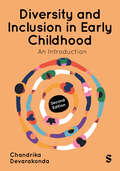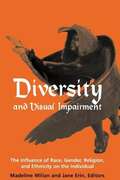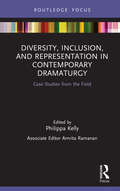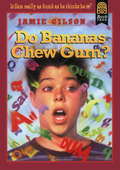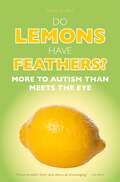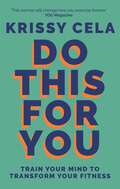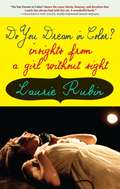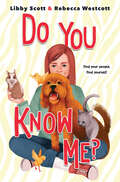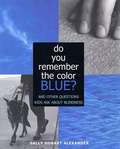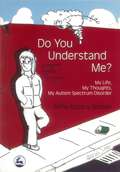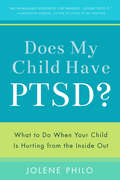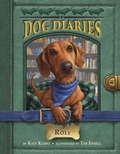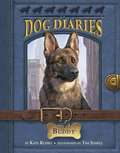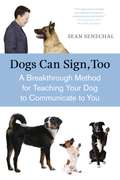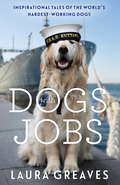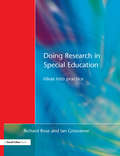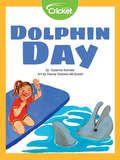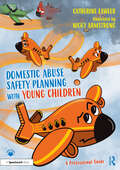- Table View
- List View
Diversity and Inclusion in Early Childhood: An Introduction
by Chandrika DevarakondaCovering a range of concepts and taking a broad perspective of what inclusion entails, this book offers an overview of current research, policy, and practice in diversity and inclusion in the early years. With case studies and activities designed to help students relate to diverse situations, the author discusses topics ranging from race, gender, and culture, to SEND and traveller children. This updated edition contains: * New chapter on Intersectionality * New chapter on Poverty & Inclusion * New chapter on Medical Needs & Inclusion * Revised references to policy and legislation * Updated content throughout to fit contemporary contexts
Diversity and Visual Impairment: The Influence of Race, Gender, Religion, and Ethnicity on the Individual
by Madeline Milian Jane N. ErinA scholarly collection of insightful essays which look at how visual impairment interacts with certain social characteristics to affect human personalities.
Diversity, Inclusion, and Representation in Contemporary Dramaturgy: Case Studies from the Field (Focus on Dramaturgy)
by Philippa Kelly Amrita RamananDiversity, Inclusion, and Representation in Contemporary Dramaturgy offers fresh perspectives on how dramaturgs can support a production beyond rigid disciplinary expectations about what information and ideas are useful and how they should be shared. The sixteen contributors to this volume offer personal windows into dramaturgy practice, encouraging theater practitioners, students, and general theater-lovers to imagine themselves as dramaturgs newly inspired by the encounters and enquiries that are the juice of contemporary theater. Each case study is written by a dramaturg whose body of work explores important issues of race, cultural equity, and culturally-specific practices within a wide range of conventions, venues, and communities. The contributors demonstrate the unique capacity of their craft to straddle the ravine between stage and stalls, intention and impact. By unpacking, in the most up-to-date ways, the central question of “Why this play, at this time, for this audience?,” this collection provides valuable insights and dramaturgy tools for scholars and students of Dramaturgy, Directing, and Theater Studies.
Divyangjanon Ke Liye Rozgar Kaushal: दिव्यांगजनों के लिए रोजगार कौशल
by Skill India and Skill Council for Persons with Disability“दिव्यांगजनों के लिए रोजगार कौशल” पुस्तक दिव्यांग व्यक्तियों (PwDs) के लिए रोजगार और आजीविका कौशल विकसित करने हेतु एक व्यापक मार्गदर्शिका है। यह पुस्तक विशेष रूप से लोकोमोटर दिव्यांगता, दृष्टिबाधित, श्रवण बाधित और अन्य दिव्यांगता वाले व्यक्तियों को ध्यान में रखकर तैयार की गई है। 70 घंटे के इस प्रशिक्षण पाठ्यक्रम में आत्मनिर्भरता, आत्मविश्वास निर्माण, और रोजगारपरक कौशल पर जोर दिया गया है। इसमें आत्म-जागरूकता, प्रभावी संचार कौशल, साक्षात्कार की तैयारी, रिज़्यूमे लेखन, और समय प्रबंधन जैसे व्यावसायिक कौशल शामिल हैं। साथ ही, डिजिटल साक्षरता के तहत कंप्यूटर का उपयोग, ईमेल संचालन और ऑनलाइन संसाधनों तक पहुंच के तरीकों को भी सिखाया गया है। पुस्तक में स्वरोजगार और उद्यमिता को बढ़ावा देने के लिए रोजगार के विविध विकल्पों और व्यावसायिक योजनाओं की जानकारी दी गई है। सरल भाषा, चित्रों, और व्यावहारिक गतिविधियों के माध्यम से इसे सभी के लिए सुलभ बनाया गया है। यह केवल एक प्रशिक्षण पाठ्यक्रम नहीं, बल्कि दिव्यांगजनों के सशक्तिकरण और आत्मनिर्भरता की दिशा में एक महत्वपूर्ण पहल है। Skill India और SCPwD (Skill Council for Persons with Disability) जैसे प्रतिष्ठित संगठनों के सहयोग से विकसित, यह पुस्तक न केवल दिव्यांगजनों के लिए उपयोगी है, बल्कि प्रशिक्षकों और मार्गदर्शकों के लिए भी एक अनूठा संसाधन है। इसका उद्देश्य दिव्यांगजनों को उनके कौशल और क्षमताओं का अधिकतम उपयोग करने के लिए प्रेरित करना है, जिससे वे रोजगार के अवसरों को प्राप्त कर सकें और समाज में सम्मानजनक जीवन व्यतीत कर सकें। आत्मनिर्भरता और सशक्तिकरण पर केंद्रित यह पुस्तक दिव्यांगजनों के जीवन को सकारात्मक रूप से बदलने की दिशा में एक प्रभावी प्रयास है।
Divyangoni Duniya: દિવ્યાંગોની દુનિયા
by Prof. Dr. Ashwin Jansariઆ પુસ્તક નો હેતુ દિવ્યાંગ બાળકો અને વ્યક્તિઓની મુશ્કેલીઓ અને સમસ્યાઓ અંગે જાણકારી મેળવવાનો છે. તેઓ કેવી રીતે સમાયોજન મેળવી શકે, વિવિધ યોજનાઓ અને અન્ય બાબતો અંગેના લેખો દ્વારા જાણવા મળે છે.
Do Bananas Chew Gum?
by Jamie Gilson Michael GarlandSam has made it most of the way through sixth grade, barely able to read and write, but now Sam's family have moved again and he is faced with the prospect of attending a new school. How long will he be able to keep his problem secret?
Do Lemons Have Feathers?: More to Autism than Meets the Eye
by David J. Burns Andrew Sercombe"Are you beginning to see past the disability and starting to appreciate the gift?" In this unashamedly honest book, David J. Burns draws on his own lived experience of Autism Spectrum Disorder (ASD) to provide guidance on how to take advantage of the supposed disadvantage. The book is filled with often hilarious anecdotes, spanning the confusion of his early diagnosis, to his marriage and life with his four children, as David proffers his advice on how to cope with everything from school work to flirting. Part memoir, part guide, and written with a refreshingly funny outlook, this book can be picked up and dipped into whether you're looking for encouragement, practical coping strategies, or a perspective of life as seen through the lens of ASD.
Do This for You: How to Be a Strong Woman from the Inside Out
by Krissy CelaA toolkit for being a strong woman in both mind and body, from global fitness sensation, Krissy Cela.Fitness is as much about the mental journey as it is the physical; many women second-guess themselves and put their needs last. In Do This for You, Krissy takes this challenge head-on and shares her empowering, no-nonsense approach to leading a guilt-free, active, healthy and happy lifestyle, giving you the skills to be both strong and confident.Through her expert coaching, you will learn to build a positive framework to 'sculpt the mind' by finding what motivates you and by challenging your mental barriers and preconceptions, as well as providing simple techniques to build healthy habits that last.Krissy will also help reframe your thoughts around eating well and exercise, all while keeping things realistic, achievable and fun - nobody should give up the things they love or beat themselves up at the gym. Instead, the focus is on listening to what your body needs and developing a deeper sense of self-confidence and determination that will radiate into every corner of your life.
Do You Dream in Color?: Insights from a Girl without Sight
by Laurie RubinColors, Rubin tells us, affect everyone through sound, smell, taste, and a vast array of emotions and atmospheres. She explains that although she has been blind since birth, she has experienced color all her life. In her memoir Do You Dream in Color?, Laurie Rubin looks back on her life as an international opera singer who happens to be blind. From her loneliness and isolation as a middle school student to her experiences skiing, Rubin offers her young readers a life-story rich in detail and inspiration drawn from everyday challenges. Beginning with her childhood in California, Rubin tells the story of her life and the amazing experiences that led her to a career as an internationally celebrated mezzo-soprano. Rubin describes her past as a "journey towards identity," one she hopes will resonate with young people struggling with two fundamental questions: "Who am I?" and "Where do I fit in?" Although most of us aren't blind, Rubin believes that many of us have traits that make us something other than "normal." These differences, like blindness, may seem like barriers, but for the strong and the persistent, dreams can overcome barriers, no matter how large they may seem. This is what makes her story so unique yet universal and so important for young readers.
Do You Know Me?
by Rebecca Westcott Libby ScottIn this sequel to Can You See Me?, Libby Scott and Rebecca Westcott return with another heartwarming and eye-opening story of friendship and middle school, inspired by Libby's own experiences of autism.Everyone else in Tally's grade seems excited for their class trip... And she knows she is supposed to be too. Ever since her classmates found out she is autistic, Tally has felt more comfortable being herself. But the end-of-year trip will be an entire week -- her longest overnight trip ever. How will she sleep? What about all the bugs? What will her dog, Rupert, do without her at home?Though she decides she doesn't want to miss out, bad news strikes as soon as she arrives: She isn't bunking with her friend Aleksandra. Instead, she is rooming with her former friends and two girls from a neighboring school -- who both reject Tally on day one.Tally isn't sure she'll ever make new friends. And how will she survive for so long away from home?Told through a mix of prose and diary entries, this authentic and relatable novel is about finding your people, and learning what it takes to be a true friend.
Do You Remember the Color Blue?: And Other Questions Kids Ask about Blindness
by Sally Hobart AlexanderChildren ask questions of an author who lost her vision at the age of twenty-six, including "How did you become blind?" "How can you read?" and "Was it hard to be a parent when you couldn't see your kids?"
Do You Sometimes Feel Like a Nobody?
by Tim StaffordBack Cover: “You aren't a nobody, even if you sometimes feel that way. You are somebody. Why? Because God has made you, and you matter to him. Do You Sometimes Feel Like a Nobody? helps you experience that good news when you're feeling bad. It helps you face yourself, and face God and others. It's honest and realistic--and above all, hopeful * You don't have to be affected by ugly nobody feelings. * You can take risks and achieve. * You can learn to see the good things that you do. * You can learn to love yourself. * You can learn to accept the love of others. * You can stop hiding your weakness or insecurities. * You can get past your guilty feelings. * You can see yourself as God sees you--as a valuable person, full of potential. What can bring about such momentous change? Just facing yourself won't do it. Only God can free you. God's love, understood and accepted, can make you feel like a somebody.” To illustrate the above points, Tim Stafford uses a variety of different genres: true accounts of people struggling with and overcoming shyness and other problems; poetry; and didactic instruction. Even though this book is designed for adolescent readers, adults can benefit from reading it too.
Do You Understand Me?: My Life, My Thoughts, My Autism Spectrum Disorder
by Sofie Koborg BrosenSofie Koborg Brøsen is eleven years old and, like other children of her age, goes to a mainstream school, loves reading comics and being with her family and her cat, Teddy. But Sofie is not the same as everyone else - she has autism spectrum disorder. Fed up with being misunderstood by her classmates, she has written a book about her world so others can learn to understand her, and vice versa. Sofie describes her day-to-day life in clear, unambiguous language and tells readers about things she finds difficult: being given too many instructions, disruptions to her routine, being teased, strong lights and smells and too much noise. She also tells about what she really likes - feeling accepted by other children, reading, nature, her autism camp and her cat. This fully illustrated book has already attracted much positive attention in Denmark. It is a readable insider's view of life as a child with autism attending a mainstream school and will be an invaluable resource in helping other children to understand their classmates with autism spectrum disorders. Teachers, parents, carers, support workers, children with autism spectrum disorders and their classmates will find this an entertaining, informative and attitude-changing read.
Does My Child Have Ptsd?: What to Do When Your Child Is Hurting from the Inside Out
by Jolene PhiloA mother, advocate, and educator shares research and personal experience in this guide to help anyone care for children dealing with PTSD.Is it possible that the struggles you have with your child may be because he or she suffers from post-traumatic stress disorder (PTSD)? Once ignored, even by the medical professionals treating war veterans, PTSD is gaining global recognition as a very real and serious issue for those who have experienced traumatic events, even children. When children experience medical illness, witness violence, or are abused, it can leave a lasting effect. According to recent studies, 50 to 60 percent of children who experience these traumas early in life may suffer from a form of PTSD, leading to issues in childhood, through adolescence, and even into adulthood. Does My Child Have PTSD? is designed for readers looking for answers about the puzzling, disturbing behaviors of children in their care. With years of research and personal experience, Philo provides critical information to help people understand causes, symptoms, prevention, and effective diagnosis, treatment, and care for any child struggling with PTSD. “Philo’s dramatic story will capture the reader's attention, and there’s tremendous value in her patient explanations, from a simple definition of trauma to an exploration of PTSD causes, myths, and common terminology. . . . Though occasionally heart-wrenching, the book is organized so simply and logically as to be easy to follow and digest. Each chapter ends with “reflection questions” and additional valuable resources. Philo concludes on a hopeful note, providing encouragement and reassurance for other families in similar situations.” —Publishers Weekly, Starred Review
Dog Diaries #10: Rolf
by Kate Klimo Tim JessellA dachshund loses a leg and finds his life's calling—as a therapy dog! Scrappy dachshund Rolf von Noodle may be missing a hind leg, but he's got attitude and can-do spirit to spare! If anything, his tripod status gives him something special: real empathy for people overcoming physical challenges. And as his owner Mindy discovers, it makes him an ideal choice to become a therapy dog. With realistic black-and-white illustrations and an appendix that includes photographs and information about the American Kennel Club's Canine Good Citizen program, therapy dog training, tripod dogs, and more, this is the kind of fact-based fiction reluctant middle grade readers sit up and beg for!
Dog Diaries #2: Buddy (Dog Diaries #2)
by Kate Klimo Tim JessellA German shepherd--the first dog trained at Dorothy Eustis's famous Seeing Eye guide-dog school for the blind--looks back at her life. Chosen for her intelligence, obedience, and willingness to learn, Kiss knows there is more to life than chasing balls and chewing bones. She is a Noble Creature and Great Things await her. But after spending months learing to take care of her beloved trainer Jack, why does he suddenly want her to take care of Morris--a strange, clumsy man who wants to wants to change her name to Buddy? Could it be that Morris needs Kiss to take care of him even more than Jack did? Based on a true story, and featuring realistic black-and-white illustrations by Tim Jessell (plus an appendix with information about German shepherds, the history and training of guide dogs, hosting guide-dog puppies, and much more), this canine confessional is pitch-perfect for smart, dog-crazy, early middle-grade readers!
Dog Diaries #8: Fala
by Kate Klimo Tim JessellPresident Franklin Delano Roosevelt's Scottie dog Fala helps run a nation! As President Franklin Delano Roosevelt's nearly constant companion, Fala the Scottish terrier was in the unique position to witness the workings of the U.S. presidency. And now for the first time, the sassy Scottie shares his story with readers--from his idyllic puppyhood spent chasing squirrels through his adulthood spent chasing dignitaries around the world with FDR! This entertaining tail (that is, tale) gives middle-graders a dog's-eye view of the events leading up to the United States entering World War II, as well as a look at the private side of FDR's life in a wheelchair. Based on primary source material, with realistic black-and-white illustrations and an appendix including information about President Franklin Delano Roosevelt, World War II, Scottish terriers, and more, this is the kind of historical fiction that begs to be read by reluctant readers. It's a perfect choice for supporting Common Core State Standards.From the Trade Paperback edition.
Dogs Can Sign, Too: A Breakthrough Method for Teaching Your Dog to Communicate
by Sean SenechalImagine being able to ask your poodle, "Who's at the door?" and having her respond, "It's Katy." Or asking your golden retriever, "Do you want a treat?" and him responding, "No, water." Or asking your Border collie, "Which toy do you want?" and getting the response, "Stick." If you've ever wondered what dogs would tell us if they could, now you can find out. The K9Sign system teaches dogs to communicate to us-making it a first in any dog training book category.Dogs Can Sign, Too is the first book dedicated exclusively to the K9Sign system for teaching dogs to communicate to their human companions using a vocabulary of gestures.This extraordinary education tool, developed by the creator of AnimalSign Language exclusively for the canine community, teaches people and their pets a unique mode of communication that employs an extensive lexicon of specific signs. Sample signs range from general concepts, such as "Food" or "Play" to identifying special treats, such as "Liver" or "Cheese" and specifying a favorite toy, such as "Ball" or "Frisbee." Signs also include useful questions such as "Who's that?" or "What type?" to naming a particular friend or family member, or even indicating a stranger. Learning and practicing K9Sign is a fun, challenging, and rewarding experience for both you and your dog that is sure to deepen the human-canine bond while expanding our ideas about interspecies communication.
Dogs With Jobs: Inspirational Tales of the Worlds Hardest-Working Dogs
by Laura GreavesMeet Molly Polly, the diabetes alert dog whose round-the-clock job is to keep her two young owners healthy; Bailey, the Assistant Director of Seagulls, who keeps the pesky birds away from the heritage vessels at the Australian National Maritime Museum; and Daisy, the Collie mix who's a full-time guide dog for another dog. From inspirational moments of bravery to dogs doing the jobs that no one else can, these are the life-affirming stories of the most remarkable dogs on the planet.
Dogs With Jobs: Inspirational Tales of the World’s Hardest-Working Dogs
by Laura GreavesMeet Molly Polly, the diabetes alert dog whose round-the-clock job is to keep her two young owners healthy; Bailey, the Assistant Director of Seagulls, who keeps the pesky birds away from the heritage vessels at the Australian National Maritime Museum; and Daisy, the Collie mix who's a full-time guide dog for another dog. From inspirational moments of bravery to dogs doing the jobs that no one else can, these are the life-affirming stories of the most remarkable dogs on the planet.
Dogs Working for People
by Joanna FosterThis detailed book talks about the different ways dogs help or work for people. From hunting dogs, to Seeing Eye dogs, to dogs that sniff out bombs. With picture descriptions.
Dogs against Darkness: The Story of the Seeing Eye
by Dickson HartwellThis book is a moving and an inspirational story of the first seeing eye dog in America, Buddy, and his master, Morris Frank.
Doing Research in Special Education: Ideas into Practice
by Richard Rose Ian GrosvenorThis book incorporates an international perspective of research related to special education across all phases of education. It draws upon the experience and expertise of recognized researchers and practitioners in special education. As a research handbook for practicing teachers this book provides exemplars of good classroom based research practice addressing a broad range of special needs issues. Methods are presented which can be generalized to situations beyond the case studies immediately presented.
Dolphin Day
by Suzanne Kamata Stacey Dressen-McQueenToday was a special day for Maria and her family–it was dolphin day! Maria is hard of hearing and is concerned it will be difficult to communicate with the dolphins at the Dolphin Research Center. Once Maria meets Sparky and Sally, her fears float away! Join the adventure as Maria, her brother Jack, and their mother and father, feed the dolphins and watch them flip and twirl in the water!
Domestic Abuse Safety Planning with Young Children: A Professional Guide (Safety Planning with Young Children)
by Catherine LawlerThis guidebook is an essential companion to the Pilgrim’s Bumpy Flight story and is designed to be read by professionals to ensure the effective and safe use of the storybook. Pilgrims Bumpy Flight has been created to help young children aged 5–7 experiencing domestic abuse, to explore the concepts of physical and emotional safety. Safety planning with a child offers a way to help them vocalise their feelings and understand what to do when something does not feel right. The professional guide will help supporting adults facilitate safety planning that is experienced as emphatically curious, safe and where the child’s opinion matters. It provides up-to-date information on domestic abuse, childhood trauma, practice tips and how to complete a safety plan with a young child using the storybook as the key vessel of communication and exploration. Key features include: • Accessible information about domestic abuse and coercive control based on the latest research. • Guidance around direct work and safety planning with young children. • Practical activities building off Pilgrim’s story, including printable material. • Things to consider and ways to use the storybook to facilitate a conversation with a child, as well as page-by-page helpers notes on the narrative. • A comprehensive list of helplines and organisations in place to support adult victims/survivors of domestic abuse. Used alongside the storybook, this professional guide is a crucial tool for the early years sector, education staff and those working in children’s services, including safeguarding officers, family support workers, social workers and children’s IDVAs. Both books should be used in tandem with agency policy, procedure and guidance.
